Over the last week I’ve been analyzing a set of papers from a research group at Brigham and Women’s Hospital, which falls under the Harvard Medical School. The papers have the usual image problems we unfortunately encounter so often, such as duplicated photos of mice and overlapping Western blots.
But this set also includes a 2022 paper that appears to have copied/pasted several figure panels from other researchers and even from scientific vendors. Most of these problems were found with ImageTwin or reverse image searches.
Quick links [the spreadsheet and slide have been updated with an additional problem found on Feb 2, 2024]:
- spreadsheet with the
2829 papers found with PubPeer links [Excel file] - slide deck with the
5859 image problems found in the2829 papers [PDF].
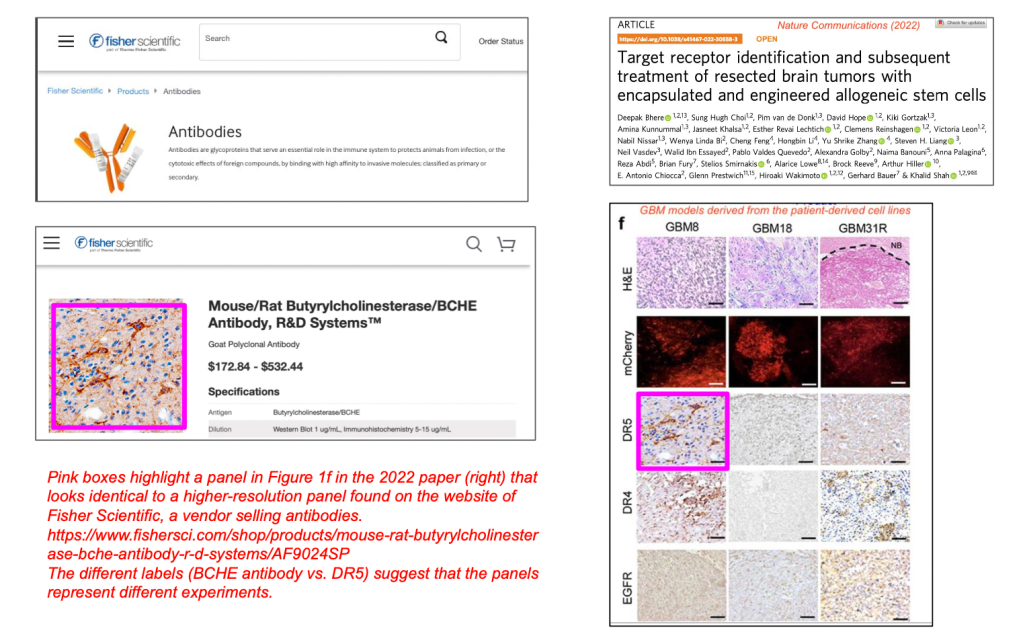
See: https://pubpeer.com/publications/FF5706E8826CB8D45481E942A679EE
A tip about questionable research practices at a Harvard Medical School lab
Two months ago I received a tip about sloppy and potentially fraudulent work at a research group at Brigham and Women’s Hospital, which is part of the Harvard Medical School. It was a story I have heard too many times before, about sloppiness in storing samples, contaminated cell lines, and bullying and threatening of PhD students and post-docs on visas to cut corners and to produce desired results. The tipster did not have a particular paper or problem for me to look at, and often such questionable research practices might not be visible by just looking at the papers produced by a lab.
But the tipster’s story was alarming enough for me to investigate some recent papers by the principal investigator (PI) of the lab, Dr. Khalid Shah. Dr. Shah has an impressive number of simultaneous jobs, any one of which might be enough to fill his day.
According to this website, ‘Dr. Khalid Shah is the Vice Chair of Research for the Department of Neurosurgery at BWH and a Professor at Harvard Medical School. He directs The Center for Stem and Translational Immunotherapy and also a joint Center of Excellence in Biomedicine. He is also the Principal Faculty at Harvard Stem Cell Institute in Boston.’ In addition, he also received a grant for ‘research and training of students from Saudi Arabia’ and ‘leads the collaborative project with Sunway University from Malaysia’. Finally, he has founded two biotech companies, one of which is AMASA Therapeutics.
He certainly sounds a busy man, with very little time left to attend to his research lab.
The Shah lab investigates gene editing as a way to treat cancer, where the genome of cancer cells or stem cells is altered to express therapeutics. The cells are then put back into the patient to kill other cancer cells, and perhaps even prevent future cancer growth. His work has been featured by BBC News, The Scientist, and WCVB news.
Dr. Shah has received several awards, including the ‘Harvard Young Mentor Award’ and a 2021 ‘Pillars of Excellence Award’ from Mass General Brigham in the area of “Integrating Diversity, Equity & Inclusion.” He also got the ‘young investigator award from Alliance for cancer gene therapy (ACGT), Research fellow award from American Cancer Society (ACS), Distinguished research award from Academy of Radiology and Innovation awards from James McDonnell Foundation, American Brain Tumor Association (ABTA) and Goldhirsh foundation’.
Funding for his lab has been mainly through the National Institutes of Health’s National Cancer Institute, amounting to millions of dollars.
A surprise finding in a 2022 Nature Communications paper
One of the first papers I checked for image problems was a 2022 Nature Communications paper by Deepak Bhere et al., Target receptor identification and subsequent treatment of resected brain tumors with encapsulated and engineered allogeneic stem cells, DOI: 10.1038/s41467-022-30558-3 [PubPeer post].
This paper, with 33 (!) authors, was featured on EurekAlert with the headline ‘Scientists develop ‘off the shelf’ engineered stem cells to treat aggressive brain cancer’. The article stated that mice with cancer receiving the treatment had a much longer survival than untreated mice, without any signs of toxicity.
I did my usual ImageTwin scan to see if any of the figure panels were duplicated or overlapping. What I found was a huge surprise.
Several images showing mouse tissues matched those of older papers from completely different groups.
ImageTwin compares each image in an uploaded scientific manuscript to a large database of Open Access images from scientific papers. It sometimes finds matches with older papers from the same group, perhaps recycled old experiments (not great) or presented as different experiments (bad), and it occasionally finds matches between two unrelated papers (very bad). Usually these unrelated papers with matching images are from paper mills, which might sell the same image or overlapping images to different buyers. It was completely unexpected to find images from a Harvard lab matching images published by a different set of authors working in a different lab.
Images copied from older, unrelated papers?
Two glioblastoma tissue panels in Figure 1e of the 2022 Nature Comms paper matched those of a 2010 PLOS ONE paper by Elrod et al., from researchers at Emory University School of Medicine, where they represented head and neck squamous cell carcinoma tissues. These panels are shown below marked with red and green boxes. The older paper is on the left, and the 2022 paper is on the right. There are no overlapping authors or affiliations, and the older images are of higher resolution and are less cropped than the 2022 images, suggesting that they were the originals.

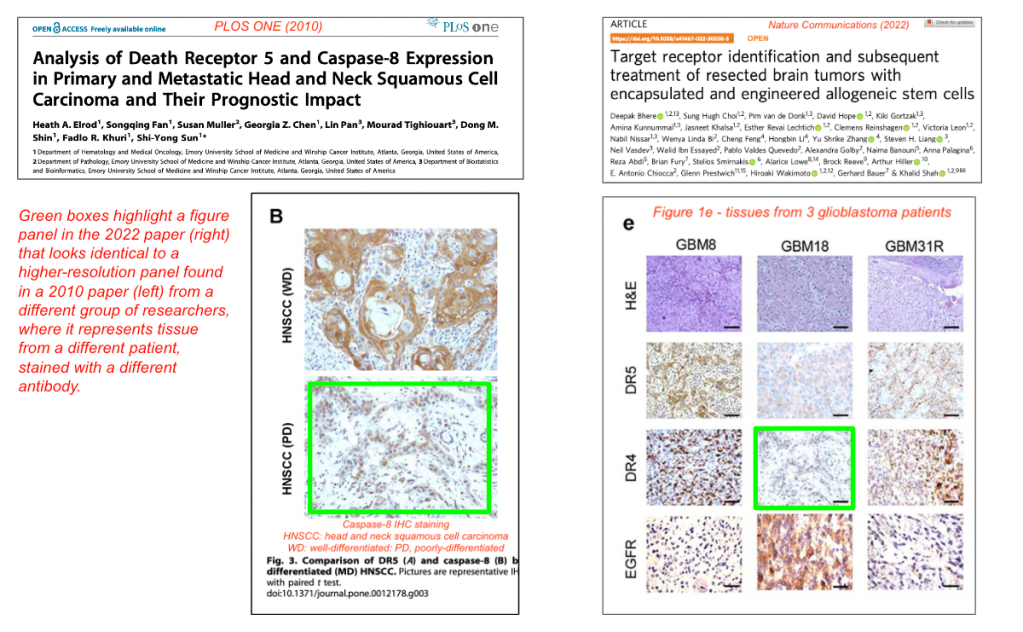
One panel in Figure 1f matched another in a 2016 Journal of Translational Medicine paper published by researchers at the University of South Florida and the Medical University of South Carolina.
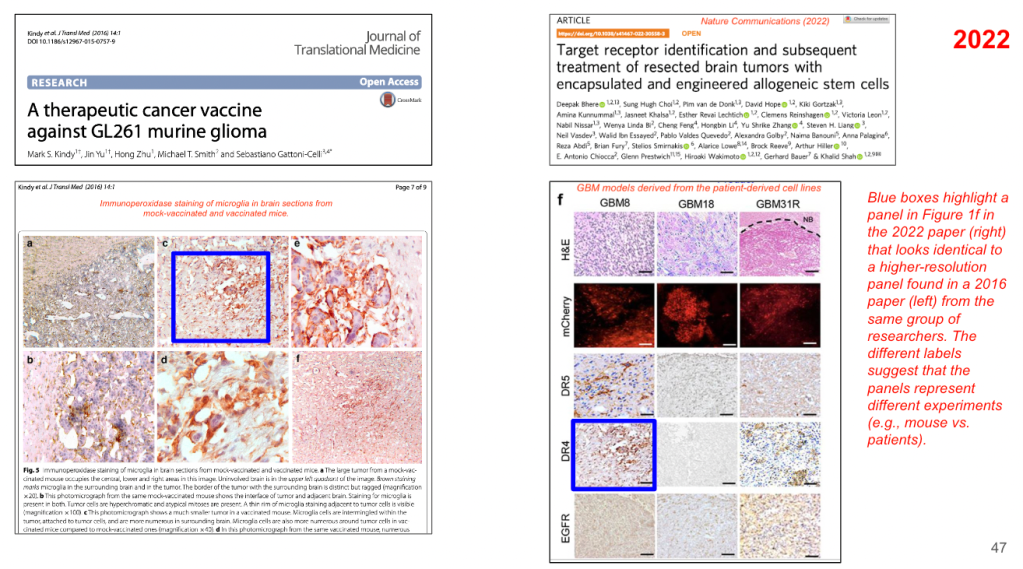
Another Figure 1f panel was taken from a 2018 Neuro-Oncology paper from the same Harvard Medical School researchers, but again appeared to be showing a different experiment.
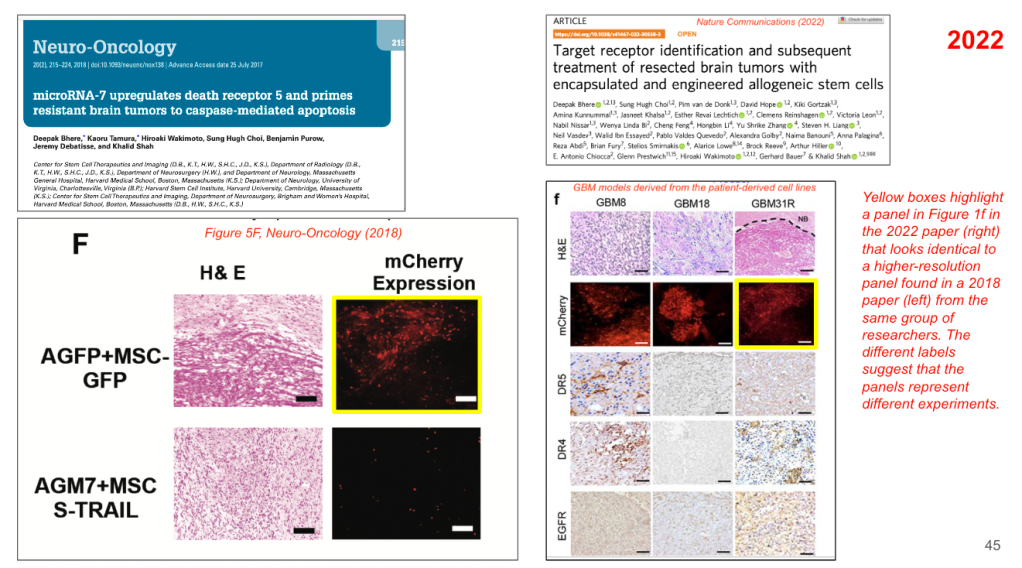
Supplemental Figure 4b has nine (!) panels that ImageTwin flagged for duplications. These panels came from the five following papers:
- Xuejiao Liu et al., Journal of Experimental & Clinical Cancer Research (2019), DOI: 10.1186/s13046-019-1235-7, from researchers at Xuzhou Medical University in China (two panels)
- Jinling Wang et al., International Journal of Nanomedicine (2016), DOI: 10.2147/IJN.S113882, from Beijing University of Chinese Medicine (four panels)
- Peng Miao et al., Neural Plasticity (2016), DOI: 10.1155/2016/3258494, from Shanghai University (one panel, Ischemic Injury in mice)
- Musi Ji et al., Experimental and Therapeutic Medicine (2017), DOI: 10.3892/etm.2017.5327, from Guangdong Medical University (one panel; representing aging in dogs)
- Yuanyuan Xu et al., G3 (2018), DOI: 10.1534/g3.118.300448, from Jilin University (one panel; representing a diabetes model in rabbits)
Note that the images in these older papers are higher-resolution; published years before the Bhere (2022) paper came out; published in mostly Open Access journals (meaning the images were included in the ImageTwin database); and not always representing mice.

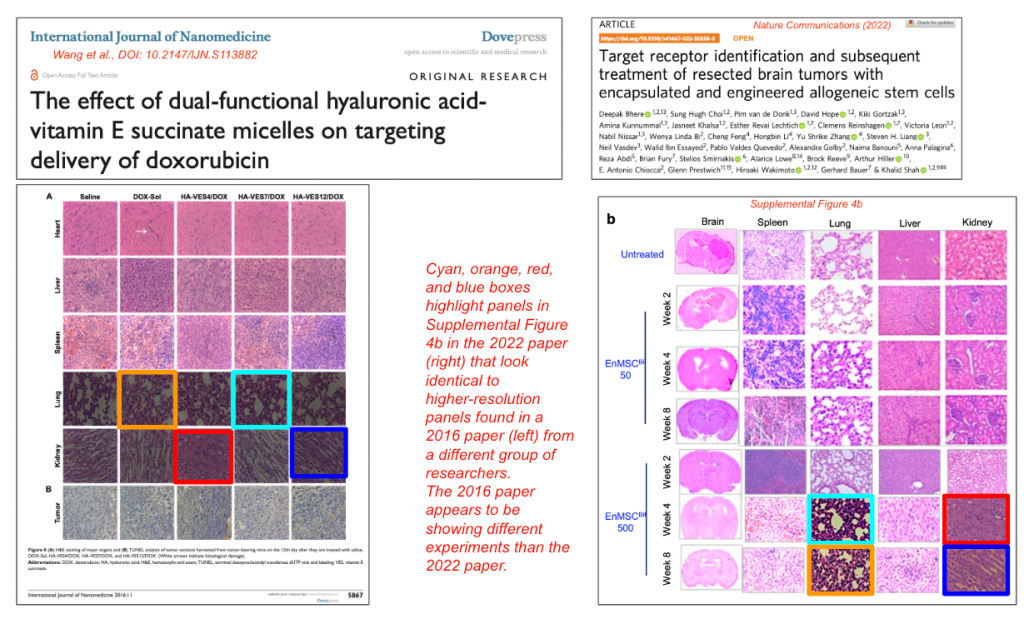
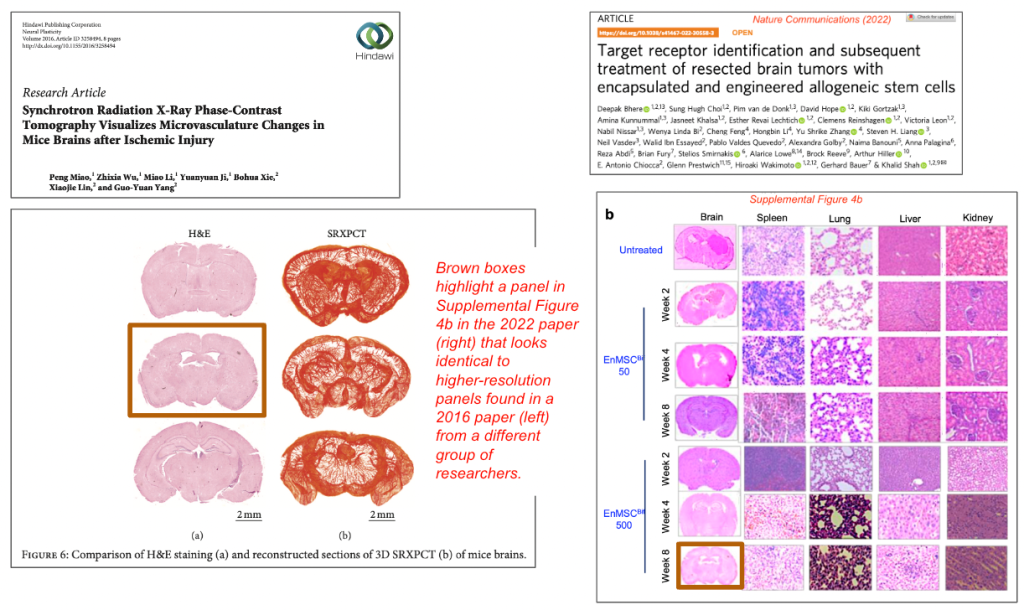


Images copied from laboratory suppliers?
Now it got weirder. I started to suspect that other panels in the 2022 Bhere et al. paper may also have been copied from other papers. Perhaps some were copied from articles that were not included in the open-access database, so ImageTwin would have been unable to find them. How could I find more of these matches?
I decided to do a Google reverse image search for each of the remaining panels. This did not yield scientific papers, but there were new surprises.
Three panels matched images of tissues and cells featuring products sold by suppliers of laboratory materials and chemicals.
One panel in Figure 1F matched an image on the Fisher Scientific website, featuring a high-resolution photo of a tissue sample stained with an antibody for Butyrylcholinesterase, a different protein than the DR5 that it represents in the 2022 paper. Fisher Scientific is an Amazon-like vendor for laboratories, selling antibodies, cell lines, glassware, labels, racks, chemicals, and equipment.
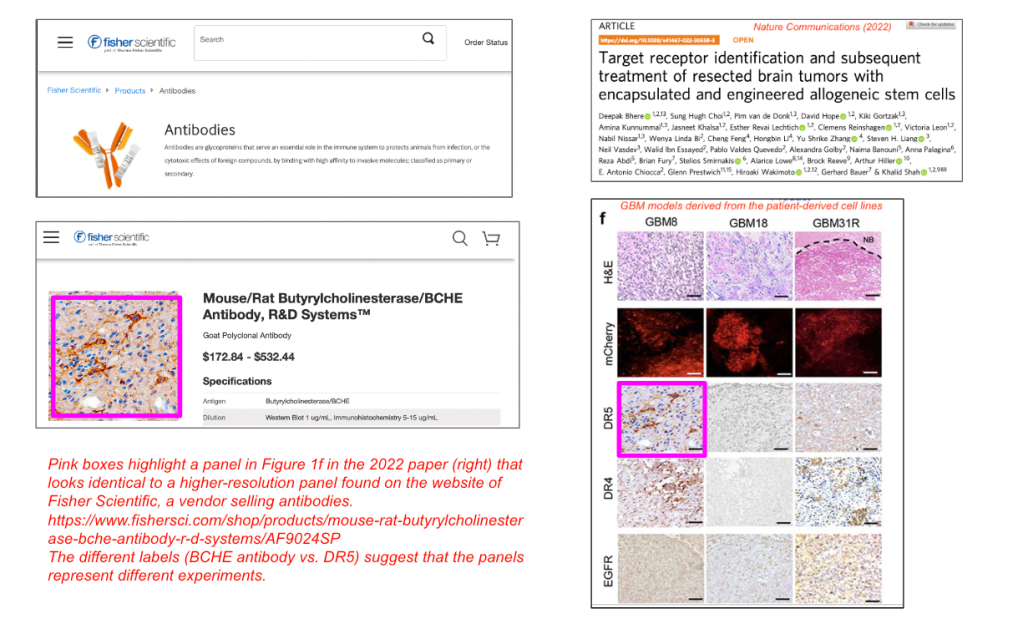
Two panels in Supplemental Figure 2a yielded matches with photos of human bone marrow-derived mesenchymal stem cells, a product advertised on the website of ScienCell (for $845, in case you wondered).


In summary, at least 12 panels in this paper appear to have been copied from unrelated papers; one panel from one of their own older papers; and three panels from scientific vendors. There was also an overlap between panels in Supplemental Figure 5a (shown on PubPeer, not here), bringing the total number of problematic images in this paper to 17.
Other problematic papers from the Khalid Shah lab
I did not find other papers from the Shah lab that appeared to contain copied images from vendors or random other papers. But I did discover 27 28 additional papers containing the regular range of image problems, such as duplicated and overlapping photos, or photos reused from papers by the same authors.
One of the oldest papers in this set is Shah et al., Role of Threonines in the Arabidopsis thaliana Somatic Embryogenesis Receptor Kinase 1 Activation Loop in Phosphorylation, Journal of Biological Chemistry (2001), DOI: 10.1074/jbc.M102381200, when a young Shah worked at Wageningen University in the Netherlands on plant research.
Figure 4 appears to show a set of duplicated lanes in the bottom panel blot.
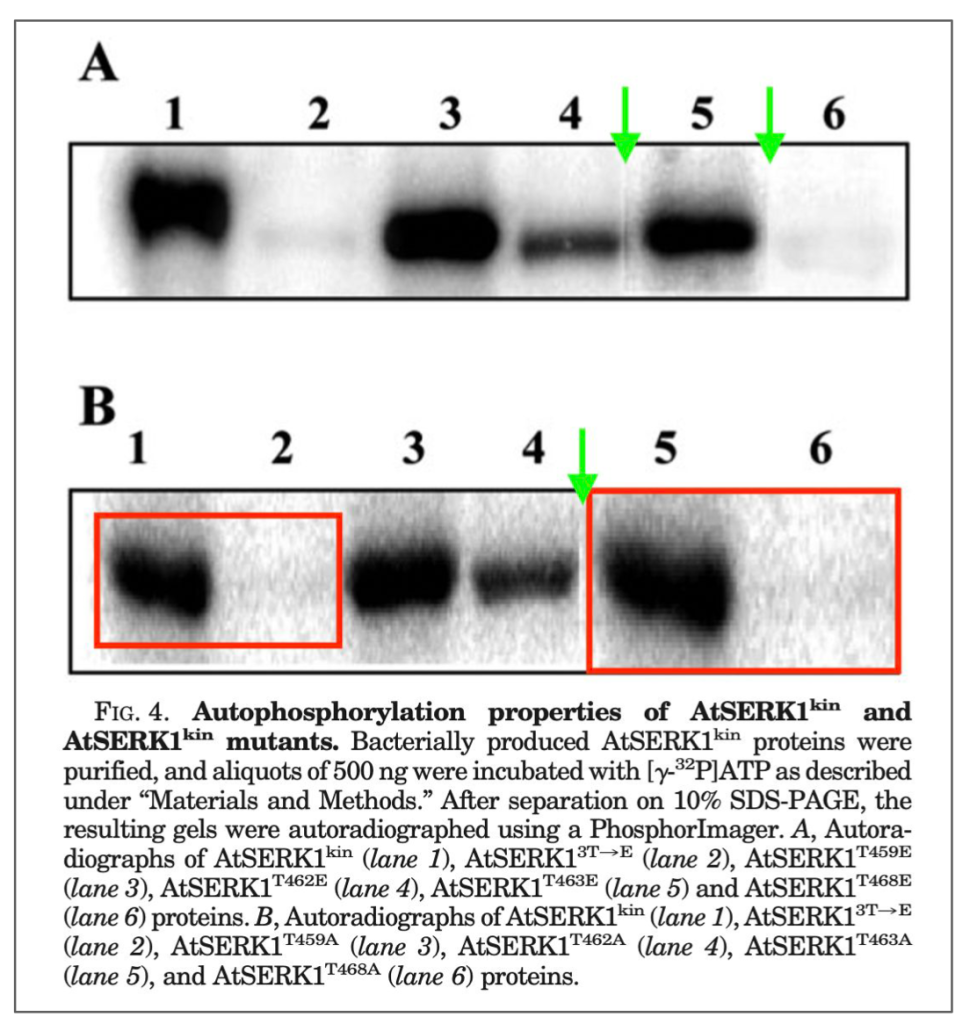
There are several papers in which photos of mice injected with tumor cells appear to have been reused. This suggests sloppiness in the correct labeling of experiments and photos, which is particularly bad in my opinion when it involves work with animals.
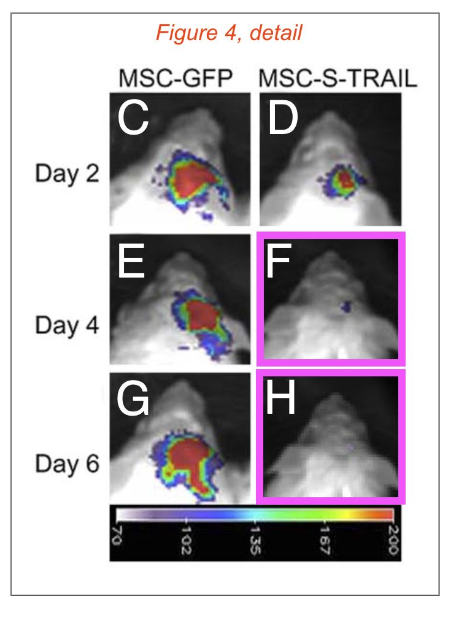
Source: Sasportas et al. PNAS (2009), DOI: 10.1073/pnas.0806647106. See: https://pubpeer.com/publications/D05650F7D55ED2BAE5A99FBFDCF39E

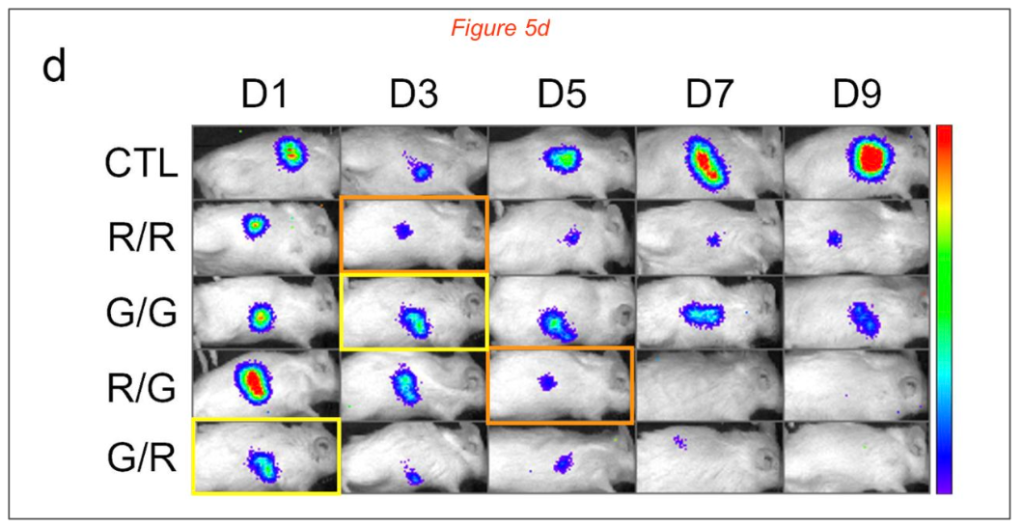
In one 2018 paper showing glioblastoma cell lines, two panels appear to have been reused from a 2017 paper where they represented colorectal cancer and lung cancer cell lines, clearly different experiments.
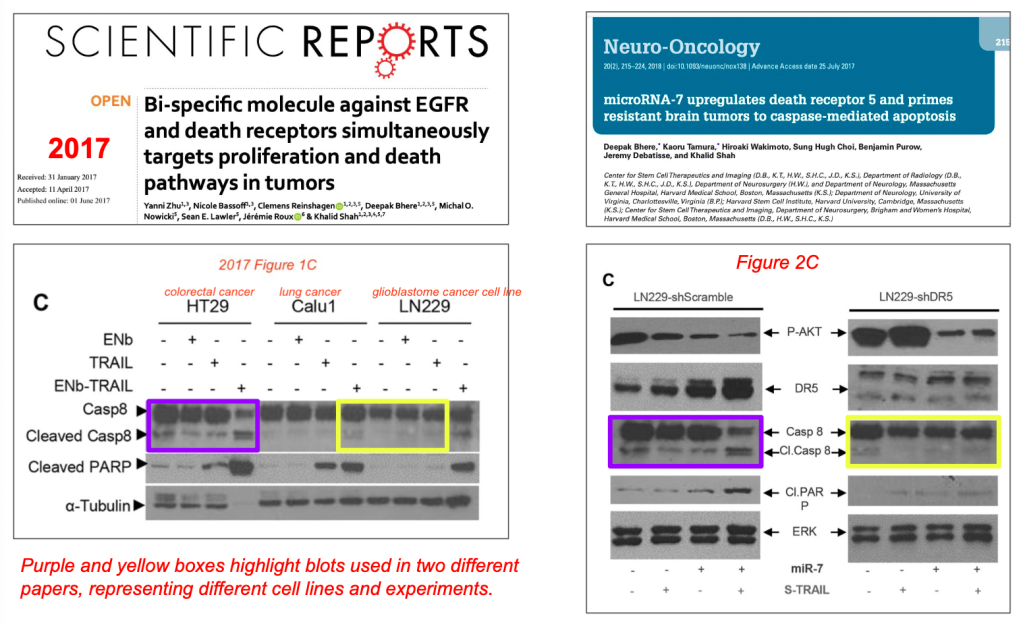
There are several more problematic papers from this group, which I have compiled in these links (I will update them if additional problems come to light).
- spreadsheet with the
2829 papers found with PubPeer links [Excel file] - slide deck with the
58image problems found in the2829 papers [PDF].
Media coverage
- Top Harvard Medical School Neuroscientist Accused of Research Misconduct – Veronica H Paulus and Akshaya Ravi – The Harvard Crimson
- Harvard Professor’s Papers Contain Copied Images, Science Sleuth Claims – Nidhi Subbaraman – Wall Street Journal
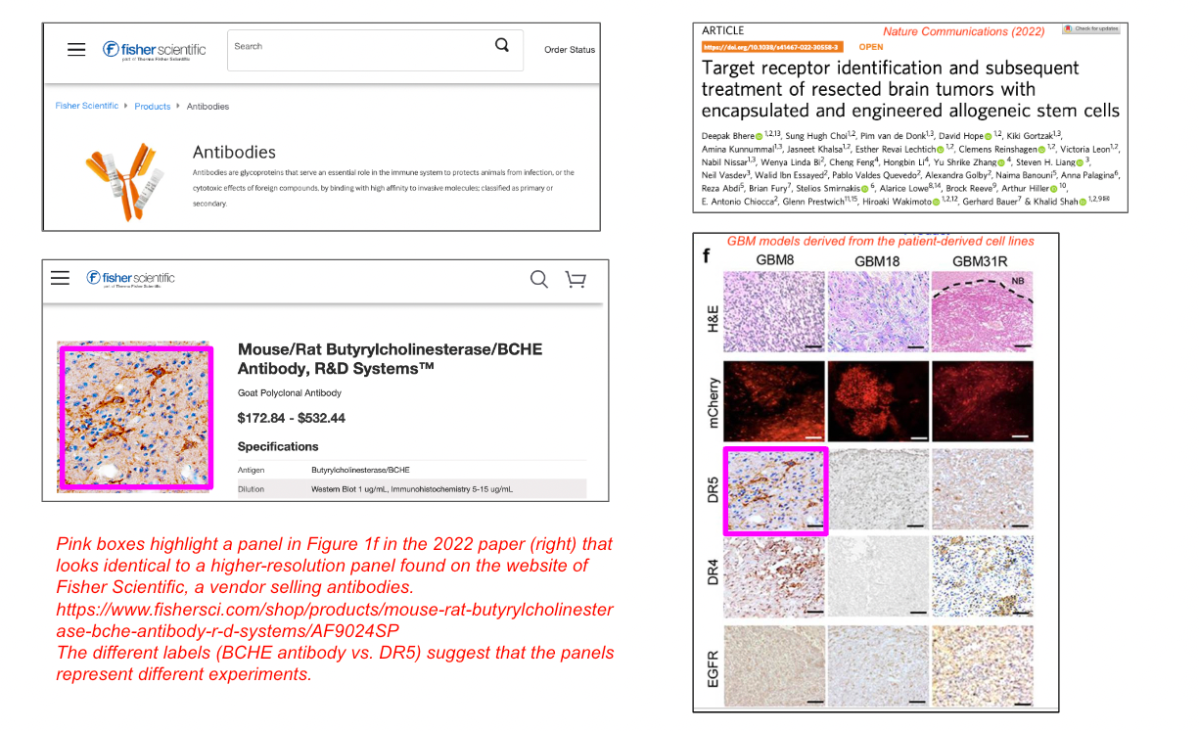

The website urls appear younger than the paper, I think you have that one the wrong way around, they stole it from the paper
LikeLike
If you read the WSJ article (link at the end of the blog post), you can see that ScienCell’s Vice President of Research stated that those images were made by the company, and that the company did not give permission for these images to be used in this publication.
LikeLike
Hotez coming in to try and do damage control? Lmao
LikeLike
excellent. How do I subscribe to your work?
LikeLike
Would you please look into papers by Dr. Joseph Loscalzo (former department chair and physician-in-chief of Brigham and Women’s Hospital)? It seems that he is blaming Asian students and researchers to cover their misconduct up. Harvard has strong legal and financial resources to protect such a person. I think journals are not actively looking into these issues. Surprisingly, he recently awarded $1-million from American Heart Association.
https://newsroom.heart.org/news/three-researchers-awarded-1-million-each-to-study-new-heart-disease-treatments-causes
https://pubpeer.com/search?q=Loscalzo
LikeLike
Joseph Loscalzo is innocent. Elisabeth Bik already stated that those issues seemed to be minor problems.
See Elisabeth Bik’s interview with MSM Reporter: “After receiving a tip, she flagged potential issues in some of Loscalzo’s co-authored papers, although she noted that these seemed to be minor problems.”
https://msmreporter.com/harvard-professor-targeted-in-cyberstalking-online-harassment-case/
Yes, Korean and Chinese students may be culprits of this research integrity issue. Joseph Loscalzo’s papers are clean, confirmed by Elisabeth Bik.
LikeLike
Joseph Loscalzo already retracted 4 papers with Piero Anversa. Moreover, there are several serious cases for one-second retraction.
– PMID: 19141618
https://pubpeer.com/publications/6A208C8F2F0A8C51E9D45DEB327214
– PMID: 12777375
https://pubpeer.com/publications/6E0F71AD366DC9DC4BACB505926ADB
– PMID: 10801753
https://pubpeer.com/publications/0DA08E61F48777BF7040996D251E52
Blaming powerless Asian students and creating sock-puppet accounts are their defense strategy. Joseph Loscalzo is so a victim of stalking on the PubPeer website…?! Nonsensical situation.
LikeLike
This is a common problem when foreign physicians aren’t closely supervised. After working in research for 40 years I couldn’t wait to retire so I no longer needed to babysit 3rd world doctor’s that in their own words had nothing to lose. It’s critical they produce positive papers to get the necessary reference for an intern ship. One of our doctors ended up not being able to produce credentials. They also refused to follow institutional protocols and regulations.
LikeLike
Very often, the problem might be the other way around. I have heard too many stories of US labs where most of the researchers are on visa, so from other countries. In such a setting, a very demanding, bullying and perhaps racist PI has a lot of power over these people, who might be terrified to lose their sponsorship. This is a situation where misconduct might start to happen.
LikeLike
My point is if the person tabulating data has a lot to lose if they are caught altering data by leaving out undesirable outcomes then they will be less likely to be tempted. The one doctor that ended up not being able to produce credentials is still to this day pretending to be the CEO and physician at a Research Company he founded. I asked him what would happen if he was exposed he said he would return to his country as a famous doctor. Principal investigators do not do their own research nor do they put together the data. They need to have trusted personnel keep an eye on the quality of research being produced and discreetly notify the principal investigators when they believe it is being compromised.
LikeLike
Another question…
How many of these “research” projects paid for with taxpayers funds?
LikeLike
If you download the spreadsheet that I linked to, you can see which grants have funded this research. It’s mainly National Institute of Health grants.
LikeLike
At the end the treatment works or it does not and at worst people die.
This has been the history of medicine from Bloodletting to penicillin.
LikeLike
Fraud in science is an old story. One good book about it is Nick Wade and Bill Broad’s old but evergreen Betrayers of the Truth. In my own lifetime, I have heard many stories from medical researchers who came through my office complaining of a rampant lack of ethics in science research (such as human experimentation in China, with the collaboration of Americans whose Harvard grants relied on Chinese cooperation). The charge used to surprise me given Harvard’s reputation, at least, in the past. In my own family, an uncle, a top zoologist who worked in the field in South America, personally observed and testified to numerous instances of fraud, fake data being made up out of whole cloth, for worthless environmental impact statements required for development projects. Enormous amounts of “green” anything is pure fraud, however well intentioned a project or a stated goal may seem at inception. There is no audit for fraud. This creates massive opportunities for crooks. The more government tries to grow science by throwing money at it, the lower the bar drops on the quality of that science. Good science requires skills and ethics, and we are now actively selecting against high quality and for fraud and corruption.
LikeLike
The problem PIs have to talk directly to the subordinates and also wear lab coats like the good old days. They are sitting in their cool comforts of their room and micromanaging through email and text messages and very obsessed with their metrics like h index. Research productivity is not a attached pdf file.
Here is Dopey
Happy: This is Dopey, he don’t talk none.
Snow White: You mean he can’t talk?
Happy: He don’t know, he never tried.
Added here
Snow White : What do the PIs do then ?
Happy : They send emails and messages only
Snow White : That’s the problem , they have to talk
LikeLike